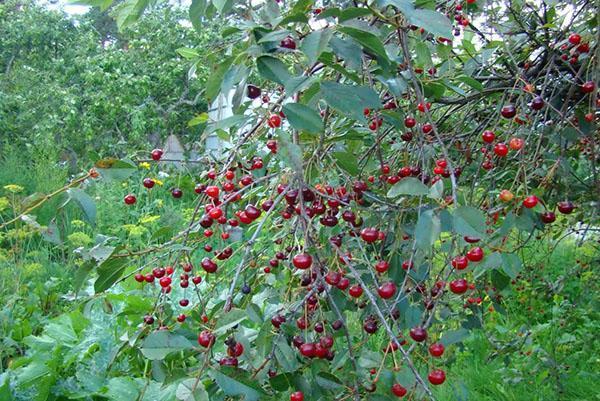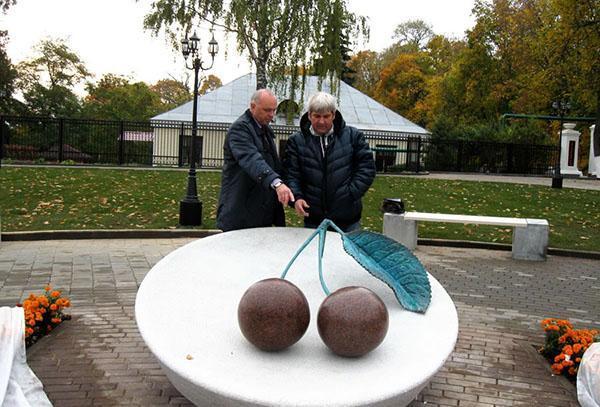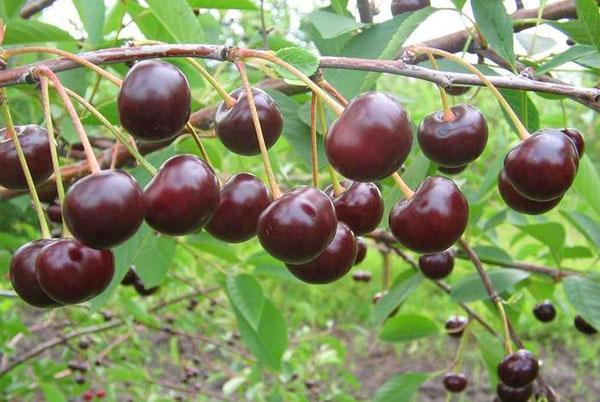Photo and description of the Vladimirskaya cherry variety
 Among modern varieties and hybrids of garden cherry, Vladimirskaya is a living historical monument to gardening in our country. Description of the variety Vladimirskaya cherry, photos of trees and ripe fruits will tell about the oldest variety in Russia, the history of the appearance and distribution of which is very reminiscent of a legend or an epic.
Among modern varieties and hybrids of garden cherry, Vladimirskaya is a living historical monument to gardening in our country. Description of the variety Vladimirskaya cherry, photos of trees and ripe fruits will tell about the oldest variety in Russia, the history of the appearance and distribution of which is very reminiscent of a legend or an epic.
The history of the appearance of the Vladimirskaya cherry variety
According to the surviving chronicles and carefully collected local legends, the first cherry trees on the Vladimir land appeared thanks to monks who made a pilgrimage to Holy Athos and brought from Greece thin saplings unseen before in Russia.
According to various sources, cherry orchards in Yaropolch or modern Vyazniki were laid from the 7th to the 12th century. Be that as it may, the plants acclimatized surprisingly easily and began to grow rapidly on the city ramparts.
Gradually, the cultivation of cherries became a profitable business, which was occupied not only by residents of the villages closest to Vladimir, but also from neighboring provinces. Crimson sweet and sour berries were carefully collected, sent to the press, and the resulting juice in barrels was sent to Moscow for the production of liqueurs and sweets. In the seventeenth century, the region became an all-Russian center of fruit growing, and cherries became a symbol of the ancient land (see. cherry chocolate - variety description).

It is not known when the Vladimirskaya cherry variety was allocated in the gardens near Vladimir, but some ancient descriptions of the varieties grown in the province in the 19th century have survived to this day:
- Vasilievskaya cherry is tasty, oblong, but not fruitful.
- The parent cherries are round and sweet. Berries are born on low trees, which are literally showered with almost black fruits.
- Kulagikha and sour produce small scarlet berries with high yields, but rather sour.
Obviously, even then folk selection was actively going on, and gardeners tried to get offspring from abundantly fruiting, with tasty berries, unpretentious trees. Cherry varieties Vladimirskaya is popular at the present time, and thanks to its wide distribution in many regions, its varieties and forms are grown, and the plant is known by synonymous names: Gorbatovskaya, Vyaznikovskaya in honor of the small homeland of culture, Izbyletskaya, Roditeleva, Dobroselskaya.
 Since 1947, the Vladimirskaya cherry shown in the photo, according to the description of the variety, has been zoned and entered into the State Register. Compact, non-capricious and stably fruiting plants are now well known to gardeners from the north-west of the country to the Central Black Earth Region and the Middle Volga.
Since 1947, the Vladimirskaya cherry shown in the photo, according to the description of the variety, has been zoned and entered into the State Register. Compact, non-capricious and stably fruiting plants are now well known to gardeners from the north-west of the country to the Central Black Earth Region and the Middle Volga.
Description of the cherry variety Vladimirskaya
Cherry, grown from root shoots or green cuttings, forms large spreading bushes more than 2 meters high and about 3 meters wide and later easily forms new root layers. The grafted cherries of the Vladimirskaya variety retain the appearance of standard trees.
The trunk and large branches of the plant are covered with a brownish-gray bark. As it grows, it becomes covered with longitudinal cracks, begins to flake off and peel off. On young, especially annual shoots, brick or yellowish tones prevail in color. It is on these thin, poorly branching, drooping shoots that the bulk of the crop is formed.
 A characteristic feature of the variety is a rather weak crown cover with foliage and the shape of the leaves themselves, as if folded along the central vein. The length of the smooth dark green leaf plates is 80–90 mm, the width is two times less. Elongated-oval leaves with a pointed tip have double-serrate serrated edges and are attached to the shoots with a small strong reddish cuttings.
A characteristic feature of the variety is a rather weak crown cover with foliage and the shape of the leaves themselves, as if folded along the central vein. The length of the smooth dark green leaf plates is 80–90 mm, the width is two times less. Elongated-oval leaves with a pointed tip have double-serrate serrated edges and are attached to the shoots with a small strong reddish cuttings.
 Cherry flowers of the Vladimirskaya variety, in the photo and according to the description, 5-7 pieces are collected in small loose inflorescences. Corolla, consisting of a goblet reddish-brown calyx, pistil, located at the same level of stamens and white petals slightly touching each other, has a diameter of 25 to 30 mm.
Cherry flowers of the Vladimirskaya variety, in the photo and according to the description, 5-7 pieces are collected in small loose inflorescences. Corolla, consisting of a goblet reddish-brown calyx, pistil, located at the same level of stamens and white petals slightly touching each other, has a diameter of 25 to 30 mm.
For the variety, mass ripening of the crop is not typical. Small or medium-sized fruits, depending on climatic and weather conditions, are ready for harvest from 10 to 25 July.
On average, 60 days pass from flowering to the appearance of the first red berries. Medium ripening fruit tastes good, sweet and sour. Berries that stay on the branches for a longer time may spontaneously crumble.
Berries weighing 2.5-3.5 grams have a slightly flattened shape with a barely noticeable seam and a small, shallow funnel. A stalk up to 45 mm long in ripe cherries is easily separated, and its loss does not violate the integrity of the fruit and does not affect its quality. The peel of ripe cherries is colored in a dense, almost black shade of burgundy. Upon closer examination, grayish spots can be discerned on the surface of the berry. The pulp is firm, burgundy-red, juicy, with noticeable fibers. Almost round or ovoid, the brown stone easily lags behind the pulp, and its weight is no more than 8.5% of the fruit mass.
The quality and composition of Vladimirskaya cherry varieties largely depends on the growing conditions. Berries obtained in the northern regions, where there is a greater lack of heat and sun, in comparison with their southern counterparts accumulate less sugar, contain more acids and moisture. Nevertheless, the fruits of the Vladimir cherry are an excellent raw material for industrial and home preservation, other types of processing, including freezing and drying, as well as for fresh consumption.
Vladimir cherry: planting care
Like many other varieties of cherries, the oldest variety from under Vladimir is self-fertile. Therefore, to obtain a good stable yield, one cannot do without planting nearby plants of other varieties.
 Trees will be the best neighbors for Vladimir cherry and pollinators for it varieties:
Trees will be the best neighbors for Vladimir cherry and pollinators for it varieties:
- Amorel pink;
- Turgenevka;
- Morel black;
- Vasilievskaya;
- Griot Michurina, Ostgeimsky, Moscow;
- Consumer goods black;
- Zhukovskaya;
- Lyubskaya;
- Fertile Michurina;
- Rastunya.
With the right approach to planting and caring for the Vladimir cherry, the culture responds with good yields. In the conditions of central Russia, up to 25 kg of fruit can be obtained from an adult tree. The excellent taste of berries, good adaptability to growing conditions and winter hardiness have provided this winter-hardy variety with centuries of popularity and fame. Until now, Vladimirskaya cherry is used not only in amateur plots, but also in industrial gardening.
 However, to the north of the Moscow Region, gardeners will have to take care of cherries in order to achieve good yields and longevity of plantings. With good winter hardiness of trees of this variety, the buds often suffer, which negatively affects the growth of trees, flowering and the formation of the ovary.
However, to the north of the Moscow Region, gardeners will have to take care of cherries in order to achieve good yields and longevity of plantings. With good winter hardiness of trees of this variety, the buds often suffer, which negatively affects the growth of trees, flowering and the formation of the ovary.
In addition, cherries are not protected from such dangerous diseases for the culture as miniliosis and coccomycosis... Therefore, in caring for the planting of Vladimir cherry, they must include preventive treatments with Bordeaux liquid or fungicides, do not forget about the sanitary pruning of fruit-bearing trees, as well as about harvesting fallen leaves and fruits not removed from the branches.